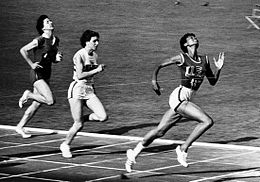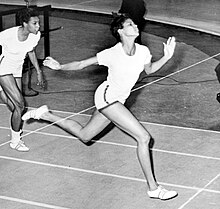Wilma Rudolph
She became a role model for black and female athletes; her Olympic successes helped elevate women's track and field in the United States.
Rudolph died of brain and throat cancer in 1994, and her achievements are memorialized in a variety of tributes, including a U.S. postage stamp, documentary films, and a made-for-television movie, as well as in numerous publications, especially books for young readers.
[8][9][10] Shortly after Wilma's birth, her family moved to Clarksville, Tennessee,[7] where she grew up and attended elementary and high school.
[11] Rudolph had several early childhood illnesses, including pneumonia and scarlet fever, and she contracted infantile paralysis (caused by the poliovirus) at the age of five.
[13] For two years, Rudolph and her mother made weekly bus trips to Nashville for treatments to regain the use of her weakened leg.
[13] Rudolph also received subsequent at-home massage treatments four times a day from members of her family and wore an orthopedic shoe for support of her foot for another two years.
[14] Because of the treatments she received at Meharry and the daily massages from her family members, Rudolph was able to overcome the debilitating effects of polio and learned to walk without a leg brace or orthopedic shoe for support by the time she was 12 years old.
During her senior year of high school, Rudolph became pregnant with her first child, Yolanda, who was born in 1958, a few weeks before her enrollment at Tennessee State University in Nashville.
Her college education was paid by her participation in a work-study scholarship program that required Rudolph to work on the TSU campus for two hours a day.
[7][12][16] Rudolph was first introduced to organized sports at Burt High School, the center of Clarksville's African American community.
After completing several years of medical treatments to regain the use of her left leg, Rudolph chose to follow in her sister Yvonne's footsteps and began playing basketball in the eighth grade.
[11] While playing for her high school basketball team, Rudolph was spotted by Ed Temple, Tennessee State's track and field coach, a major break for the active young athlete.
[19] The American team of Rudolph, Isabelle Daniels, Mae Faggs, and Margaret Matthews, all of whom were TSU Tigerbelles, won the bronze medal, matching the world-record time of 44.9 seconds.
[8][11] Rudolph had a special, personal reason to hope for victory—to pay tribute to Jesse Owens, the celebrated American athlete and star of the 1936 Summer Olympics in Berlin, Germany, who had been her inspiration.
[26] Rudolph returned home to Clarksville after completing a post-games European tour, where she and her Olympic teammates competed in meets in London, West Germany, the Netherlands, and at other venues in Europe.
"[29] In 1961, Rudolph competed in the prestigious, Los Angeles Invitational indoor track meet, where thousands turned out to watch her run.
She had also won seven national AAU sprint titles and set the women's indoor track record of 6.9 seconds in the 60-yard dash.
[36] In May 1963, a few weeks after returning from Africa, Rudolph participated in a civil rights protest in her hometown of Clarksville to desegregate one of the city's restaurants.
[38] Rudolph did not earn significant money as an amateur athlete and shifted to a career in teaching and coaching after her retirement from track competition.
[citation needed] Rudolph moved several times over the years and lived in various places such as Chicago, Illinois; Indianapolis, Indiana; Saint Louis, Missouri; Detroit, Michigan; Tennessee; California; and Maine.
[39] In addition to teaching, Rudolph worked for nonprofit organizations and government-sponsored projects that supported athletic development among American children.
In Boston, Massachusetts, she became involved in the federal Job Corps program, and Rudolph served as a track specialist for Operation Champion in 1967.
On October 14, 1961, Rudolph married William "Willie" Ward, a member of the North Carolina College at Durham track team.
After her graduation from Tennessee State in 1963, Rudolph married Robert Eldridge, her high school sweetheart, with whom she already had a daughter, Yolanda, born in 1958.
[1][45][46] Rudolph's legacy lies in her efforts to overcome obstacles that included childhood illnesses and a physical disability to become the fastest woman runner in the world in 1960.
"[12] Rudolph's celebrity also caused gender barriers to be broken at previously all-male track and field events such as the Millrose Games.
[12][52] In 1994, a portion of U.S. Route 79 was named Wilma Rudolph Boulevard, extending from Interstate 24, exit 4, in Clarksville to the Red River (Lynnwood-Tarpley) bridge near the Kraft Street intersection.
[38] On November 21, 1995, the Wilma Rudolph Memorial Commission placed a black marble marker at her grave site in Edgefield Missionary Baptist Church.
[40] In April 1996, a life-size bronze statue of Rudolph was erected "at the southern end of the Cumberland River Walk at the base of the Pedestrian Overpass" at College Street and Riverside Drive in Clarksville.
[53] In 2012, the city of Clarksville, Tennessee built the Wilma Rudolph Event Center, located at Liberty Park on Cumberland Drive.





